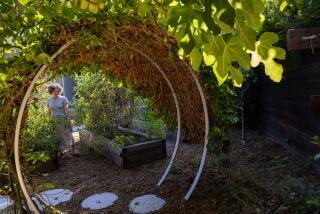Green-Lawn Mania Surfaces in Turf War Against Weeds, Pests
- Share via
Saturday morning finds Charles Blair on his hands and knees in the front yard. He inspects an emerald-green dichondra lawn.
“I like dichondra. When it’s right, it’s so lush and green,” he said. “One of my friends who has a dichondra lawn calls it his ‘crawling lawn’ because you have to crawl around on it to find the weeds. I’ve just spent the last hour picking out all the weeds . . . you know, spurge, dandelions, crabgrass.”
Blair used to leave such dirty work to the gardener. But after several brown spots appeared on the prized lawn this spring, he fired the weekly help and took matters into his own hands. The 68-year-old, who runs his own printing business, spends four to five hours at the task each weekend.
“I could afford to hire any gardener I want,” Blair said, standing in front of his spacious Tarzana home. Parked in the garage next to a John Deere lawn mower are matching Jaguar XJSs. “But I know this lawn. I’ll bring it back to health.”
Some people may fuss over their lawns out of pride, others simply to keep up with the neighbors. With 240,000 single-family homes and probably an equal number of front and backyards, the San Fernando Valley is a perfect breeding ground for green-lawn mania.
Neighborly Rivalry
“Everyone has to keep up as a neighbor by having a nice lawn,” said Peter Fliegel, a plant pathologist with the Los Angeles County Agricultural Commissioner’s office. “It’s the most important thing in any urban area.”
No one knows just how much lawn grows in the Valley. As one county official put it, you would have to start by measuring everyone’s front yards.
There are an estimated 1.3 million acres of lawn across the state, according to a 1977 University of California study. Some of this turf is found on golf courses, cemeteries and parks. But almost two thirds of it--an estimated 860,800 acres--is spread across private yards.
In an effort to keep their yards green, Californians spend $648 million each year on everything from bottles of weed killer to rakes, according to a 1982 UC study. Nationwide, the lawn care industry brings in $24 billion a year, and that doesn’t include wages for gardeners and other professional lawn tenders.
Each July and August, water usage in the Valley nearly doubles, according to Department of Water and Power records. DWP officials estimate that most of the increase is sprinkled and sprayed onto lawns from Chatsworth to North Hollywood.
‘Something of Importance’
“The family lawn is probably right behind the TV as far as something of tremendous importance,” said Bruce Morrison, a DWP civil engineering associate.
But keeping that important asset in the green isn’t easy. Summer temperatures in the Valley often top 100. Subtle differences in climate between Burbank and Granada Hills, for example, require corresponding adjustments in how grass is cared for. There are numerous varieties of grass that flourish in Southern California. Seashore paspalum should be cut short, tall fescue allowed to grow long. Any one lawn may have as many as four or five varieties growing in it.
What grandfather used to take care of with a push mower and a rake has become a proposition of technical proportions.
“Grandfather probably didn’t live in Southern California. Or his lawn probably wasn’t green all year round,” said Bob Cohen, whose company, The Green Scene, specializes in lawn care. “Either that or grandpa knew his grasses.”
Many residents wishing for greener pastures turn to gardeners. Others are enlisting the help of a newcomer to the home gardening scene: the lawn care service. These businesses, which have been popular for years in the Midwest and East, will not mow or clip your lawn. What they will do, for about $200 a year, is analyze soil and grass samples from your yard and offer instructions on mowing and watering. Then, every other month, they return to apply fertilizer and spray pesticides.
Began Business in 1969
Cohen opened his shop in 1969, shortly after graduation from UCLA. He had studied to be an engineer, but found turf grass fascinating. He speaks of grass as though it were a dear friend, albeit a small friend, for when he assumes the personality of a lawn, his voice rises slightly.
“The main thing we tell our customers is, ‘If you were grass, what would you want?’ There’re no little grasses that stand up and say, ‘Hey, you’re doing something wrong,’ ” he said, waving his hands in the air as if he were a blade of grass. “The grass just dies.
“A lot of people call us and say ‘My lawn looks like hell. What can you do?’ You have your blue grass, tall fescue, St. Augustine, Kikuyu, seashore paspalum--all of it growing right here!” He slammed a fist against the desk. “You have to understand what type of grass yours is and what the rules are.”
There are 132 companies registered with the county to perform chemical lawn service. That is a significant increase over the number of such businesses operating in Los Angeles just three years ago, according to the agricultural commissioner’s office.
ChemLawn, the industry’s largest company, until three years ago had shied away from California, seeing it as a tough market.
‘Lot of Gardeners Out Here’
“There tends to be a lot of gardeners out here. There are also a lot of do-it-yourselfers,” explained Steve Griggs, a regional technical manager for the company, which has based its Southern California operations in Newbury Park.
But ChemLawn has caught on quickly here and currently services about 800 homes in the Valley. It and other lawn care companies in this area report that business is growing 25% a year, a rate equal to the industry’s national figures. A survey of companies showed that as many as 3,000 Valley homes contract a lawn service.
Yet, all is not rosy for these businesses. The lawn care industry has been widely criticized recently for its use of pesticides. Lawn care companies now face major lawsuits and stricter government regulation in some cities (see accompanying story).
“What is a weed? W-E-E-D. Something you don’t want in your lawn is a weed. So you hire a gardener,” said Seiji Horio, president of the Southern California Gardeners Federation and a Panorama City gardener. “Just because someone can cut the grass, he is not a gardener. You have to know more things.”
There are 254 gardeners in the Valley who are registered with the gardeners federation, and probably at least that many who are not members of the federation. A sampling of local gardeners’ prices ranged from $45 a visit upward, depending on the size of the yard. Horio said the quality of gardening depends greatly on the hourly wage.
“People don’t pay enough for good gardeners,” he complained.
While a gardener’s work entails caring for flowers, shrubs and trees, lawns are still the biggest part of the job. Bob Lamberti, a Sherman Oaks gardener who has been caring for Valley yards for 16 years, estimated that lawns take up 70% of his time. Taka Iwaoka, of North Hollywood, said if he can’t keep the lawn green, he can’t keep the customer.
Despite the complexities of lawn care, a horticultural layman can fare just as well as any lawn specialist, said Victor Gibeault, one of the environmental horticulturists involved in the University of California studies.
Books Available
Gibeault said there are a variety of books available in bookstores and libraries that will help homeowners recognize and treat the type of lawn they have. The necessary fertilizers and pesticides can be purchased in garden supply stores.
“If a homeowner does his or her own fertilization, they certainly have the ability to do that and they’ll get basically a similar result,” Gibeault said.
Both the University of California and the state Department of Food and Agriculture offer printed information on turf care. DWP will send customers a free watering guide.
Like Charles Blair, John Rhone is one of the few people in his neighborhood who push their own mower. The 55-year-old Van Nuys psychiatrist breaks a light sweat working in his yard.
“We have a good neighborhood here,” he said. “It’s kind of an unspoken thing. I think we all keep our lawns up because we like the neighborhood. Most of my neighbors have gardeners. I’m one of the few left who does it himself.”
While Rhone’s lawn is neat and trim, it is not quite as healthy and green as the yards around his. But then, Rhone isn’t a fanatic about the lawn. He says he’s in it for the exercise, and maybe a few memories.
“I used to cut lawns as a kid,” he said. “For a lawn the size of this one, they might have given me 50 cents. I could make a buck and a quarter on a Saturday. That was big money. Now the only satisfaction I get out of it is my own.”







